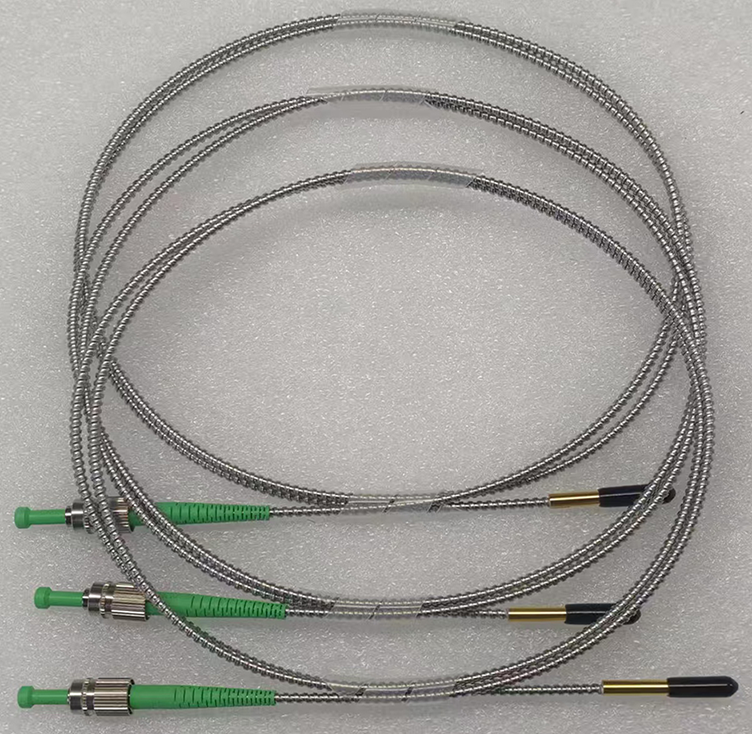Analysis of a 30W High-Power Polarization-Maintaining Fiber Collimator
I. Working Principle
● Polarization-Maintaining Fiber
*Problems with Ordinary Fiber: When transmitting high-power laser light, ordinary single-mode fiber can cause the polarization state of light propagating through the fiber to randomly change due to internal stress, bending, temperature fluctuations, and other factors. This unstable polarization state is unacceptable for many precision applications (such as material processing and interferometry).
*Solution with Polarization-Maintaining Fiber: Polarization-maintaining fiber introduces a non-circularly symmetric stress region (e.g., panda-shaped or bow-tie-shaped) near the fiber core, resulting in different propagation constants along two perpendicular axes. This strong birefringence “locks” incident linearly polarized light along one of its principal axes (fast or slow). As long as the polarization direction of the incident light is aligned with the axis of the polarization-maintaining fiber, the light maintains its polarization state during transmission.
●Collimator
The function of a collimator is to convert laser light emitted from an extremely thin fiber core (typically approximately 10μm in diameter) into a parallel beam (collimated light). Its core component is a precision lens (usually a gradient-index lens or a spherical lens).
Working Principle: According to geometric optics, when a point light source (fiber end face) is located at the focal point of a lens, the emitted light becomes parallel after refraction through the lens. The manufacturing process of a collimator involves precisely fixing the fiber end face at this focal point through precise adjustment.
● Overall Workflow
* Combining polarization-maintaining fiber with a collimating lens creates a polarization-maintaining fiber collimator:
* Polarized Light Input: A high-power, linearly polarized laser beam is coupled into the polarization-maintaining fiber, ensuring that its polarization direction is strictly aligned with one of the fiber’s principal axes.
* Polarization-Maintaining Transmission: The laser beam is transmitted through the fiber to the end with a stable polarization state.
* Collimated Output: The divergent light emitted from the fiber end face is collimated by a precision lens, becoming a parallel laser beam with a stable polarization state and a low divergence angle.
The “30W” high power means that the entire system (fiber, lens, adhesive, and metal structure) must be specially designed to withstand high power density and prevent thermal lensing and thermal damage.
II. Features
The 30W high-power polarization-maintaining fiber collimator combines high power handling, polarization maintenance, and beam collimation. Its key features are as follows:
● High power handling capability:
* Utilizes passive optical components (fiber and lens) with low absorption and high damage threshold.
* Utilizes high-power-tolerant, organic-free laser welding technology instead of traditional adhesive bonding to prevent carbonization of the glue at high temperatures.
* Optimized thermal management design effectively dissipates heat, preventing thermal lensing (change in lens focal length with temperature) and thermally induced modal instabilities.
● Excellent polarization-maintaining performance:
* High polarization extinction ratio (PER), a key indicator of polarization-maintaining performance, typically reaching 20 dB or higher. A higher PER indicates higher polarization purity and better stability.
● High collimation accuracy and low divergence:
* Extremely low beam divergence, typically <0.5 mrad, enables long-distance transmission with minimal spot size variation.
* Excellent beam quality, nearing the diffraction limit.
● High Stability and Reliability:
* Rugged metallized packaging provides vibration and shock resistance.
* Insensitive to ambient temperature fluctuations, maintaining stable operation over a wide temperature range.
● Low Insertion Loss:
* Optimized optical design minimizes total optical loss from fiber input to free-space output, ensuring efficient use of optical power.
III. Application Areas
Due to its unique technical advantages, the 30W high-power polarization-maintaining fiber collimator plays a key role in numerous high-end industrial and high-tech fields:
● Laser Material Processing:
* Precision welding and cutting: Especially in applications with stringent requirements for heat-affected zones (HAZs), such as lithium batteries, solar cells, and semiconductors, stable polarization ensures consistent and high-quality processing results.
* Additive Manufacturing: In 3D printing, it serves as the input source for laser scanning galvanometer systems, providing a stable and reliable high-power laser beam.
● Nonlinear Frequency Conversion:
* Many nonlinear optical processes (such as frequency doubling and sum frequency conversion) place extremely high demands on the polarization state of the pump light. For example, when frequency doubling an infrared laser to produce green light, linearly polarized light is required to achieve high conversion efficiency. This collimator is an ideal front-end for such systems.
● LiDAR and Remote Sensing:
* In coherent LiDAR systems, interference with the local oscillator (LO) light is required. Stable polarization states are essential for ensuring interferometric signal quality and detection accuracy. High power translates to longer detection ranges.
● Scientific Research and Metrology:
* Used in cutting-edge physics experiments such as atomic cooling and trapping, spectroscopy, and interferometry, which often require high power, high beam quality, and pure polarization.
● Defense and Aerospace:
* Used in systems such as laser communications, target designation, and directed energy weapons, all of which face extremely demanding requirements for stability and reliability in harsh environments.
● Medical Equipment:
* Used in high-power laser medical devices, such as surgical procedures and ophthalmic treatments, where precise beam control and stability are crucial.
Summary: The 30W high-power polarization-maintaining fiber collimator is the bridge between modern high-power fiber laser systems and free-space applications. It perfectly combines the flexibility of fiber systems with the beam shape and polarization control requirements of free-space optics, making it an indispensable core optical component for high-end manufacturing and scientific research.

Comments are closed